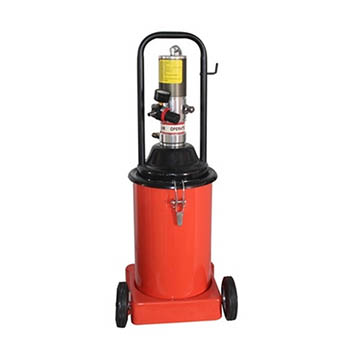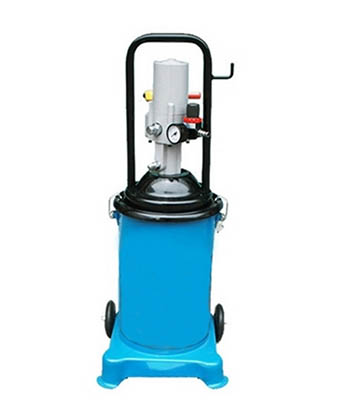How to Maintain Pneumatic Grease Pump?
With the rise of lubricating grease in the mechanical industry, pneumatic grease pumps have received extensive attention and application. Pneumatic grease is used in printing and dyeing, medicine, coating, chemical, textile, painting and other industries. It is suitable for the transportation of high-viscosity chemical slurry.
In daily use, we often find that due to improper operation, the oil injection effect will be unsatisfactory. In order to ensure the normal and orderly operation of the grease pump, the following is an introduction to the daily maintenance and attention of the pneumatic grease pump.
How to maintain grease pump?
It has the functions of explosion-proof, corrosion-resistant, anti-sedimentation, low noise, and energy saving. Easy maintenance, reliable performance, long service life, simple appearance, advanced and reasonable structure, international standard, the conveying liquid should not contain solid particles, and the conveying temperature should not be higher than 70°C.
According to the process flow, the pneumatic grease pump is considered from five aspects: liquid delivery volume, device lift, liquid properties, pipeline layout and operating conditions.
Check whether the grease pump pipeline and joints are loose. Turn the grease pump by hand to see the flexibility of the grease pump. Add bearing lubricating oil to the bearing body, observe that the oil level should be at the center line of the oil mark, and the lubricating oil should be replaced or replenished in time. Unscrew the water diversion plug of the pump body, and pour water (or slurry).
During the use of the pneumatic grease pump, prevent it from hitting the pneumatic cylinder body to avoid deformation, and the piston will be stuck, resulting in scrapping. After the piston has been operated for more than 10,000 times, the cylinder body should be cleaned immediately and lubricating oil should be injected according to the water accumulation during the air supply process of the air compressor. If it is not used for a long time, it should be cleaned in a solvent to prevent the slurry from freezing and blocking the guide tube.
During work, if the cylinder body becomes hot (according to the feeling of heat), lubricating oil should be added immediately. If the adjusting nut is loose during use and material leakage occurs, the nut should be adjusted in time. Check the pipeline connection of the pneumatic grouting pump at any time to ensure that there is no air leakage, no rupture or other damage during the operation of the pneumatic grease pump, and no damage to the hose.
The air pump part needs to be lubricated regularly. In the process of disassembly, repair and assembly, attention must be paid to the accuracy of the folded parts. Do not leave the inside of the pneumatic grease pump empty for a long time to avoid dry friction, otherwise it will affect the service life of the grease pump. Pneumatic grease pumps should be cleaned and maintained at ordinary times, and the entire oil passage system should be cleaned within a certain period of time. The clean engine oil should be reciprocated several times to flush the dirt in the pipe, and the oil storage cylinder should be cleaned frequently to keep the inside of the cylinder clean.
Compressed air should be filtered to prevent dirt from entering the air pump and wearing the air distribution slider and cylinder parts. It is strictly forbidden to use flammable gas as power. The compressed air force should not exceed 0.8Mpa to avoid equipment overload and affect the service life of the equipment itself and the high-pressure pipe. High-pressure rubber hoses are not allowed to be bent strongly, dragged on the ground, or crushed by heavy objects during use, which will affect the service life of the oil hose. When the pneumatic grease pump is working and resting, the air quick change joint should be removed, and the trigger of the oil gun should be pulled down to reduce the oil pressure in the equipment to avoid long-term pressure on the high-pressure rubber hose
Regularly check the slurry suction valve and slurry discharge valve to see if there is any blockage at the air inlet filter. Check the filter, if there is accumulated water, open the small hose at the lower end to release the water. If the regulating valve cannot be adjusted close to the air source pressure, the filter cup should be cleaned. Check the oil mist lubricator, press the nut to remove the nut, and take down the oil cup to add oil. Adjust its top knob, about 5-6 seconds 1 drop of oil.
If the air pressure is sufficient but the reciprocating speed of the pump is too slow, the muffler should be cleaned (when the pneumatic grouting pump is empty). The stroke reversing valve controls the small reversing valve, and then controls the action of the two-way air-controlled reversing valve to alternately supply compressed air to the cylinder. Do not push the plunger of the stroke valve casually after the pump is stopped, otherwise the pneumatic grease pump may fail due to the wrong position. At this time, the stroke valve can be removed, and the ejector rod can be pushed by hand for testing. The parts of the pneumatic oil pump are always kept clean, and there must be no dust and dirt at the valves and around the plunger.
Remove the connecting pipe connecting the lubricator to the reversing valve, remove the pipeline of the stud on the upper cylinder head, and remove all pneumatic components together. When installing the plunger V-shaped seal ring, pay attention to the direction of its lip. Each piece should be coated with yellow oil. The total length of the whole set of sealing rings should be about 2 mm long so that it has a pre-compression amount (adjusting pads can be added).
Close the gate valve, outlet pressure gauge and inlet vacuum gauge of the water outlet pipeline. Jog the motor to see if the direction of the motor is correct. Start the motor, and when the grease pump is running normally, open the outlet pressure gauge and the inlet vacuum pump to see the appropriate pressure, then gradually open the gate valve, and check the load of the motor at the same time. Try to control the flow rate and head of the grease pump within the range indicated on the label to ensure that the grease pump operates at the highest efficiency point to obtain the greatest energy-saving effect.
During the operation of the grease pump, the bearing temperature should not exceed the ambient temperature of 35℃, and the maximum temperature should not exceed 80℃. If abnormal noise is found in the grease pump, stop the machine immediately and check the cause. To stop using the grease pump, first close the gate valve, pressure gauge, and then the motor.
Maintain precautions
Compared with manual or other oiling equipment, this kind of equipment has higher oil injection efficiency and safety. Everyone knows that the equipment often encounters some failures when it is in use, so compared to the pneumatic grease pump, how should we repair it when it fails?
When the pump is suddenly stopped for oil injection, the reversing mechanism fails. Check whether the parts of the reversing mechanism are stuck, and then adjust or replace them. When the grease pump leaks air, check that the slider and the air distribution valve seat are in contact with the flat slider. When the output oil pressure is insufficient, check that a certain part of the output pipe is blocked. If the oil delivery is not smooth, check the blockage and clean it. Part of the oil passage in the grease gun is blocked, disassemble the grease gun, clean and unblock the blocked part. The two one-way valves of the plunger rod are stuck with foreign matter, remove the plunger rod, clean and dredge. There is foreign matter between the check valve and the oil inlet valve seat, then disassemble the oil inlet valve seat and clean it.
When exhausting, oil is discharged from the U-shaped sealing ring and oil leakage is replaced with a new U-shaped sealing ring. Oil leakage from the rotating part of the grease gun. The polyurethane oil seal is worn or damaged and replace with a new seal. When it is found that the oil in the oil storage tank is insufficient, replenish the oil in time. When there is foreign matter stuck in the check valve, it should be removed in time.
The above is the introduction of the troubleshooting method of the pneumatic grease pump. I believe that everyone will be able to find the equipment failure in time in life and make correct maintenance.

